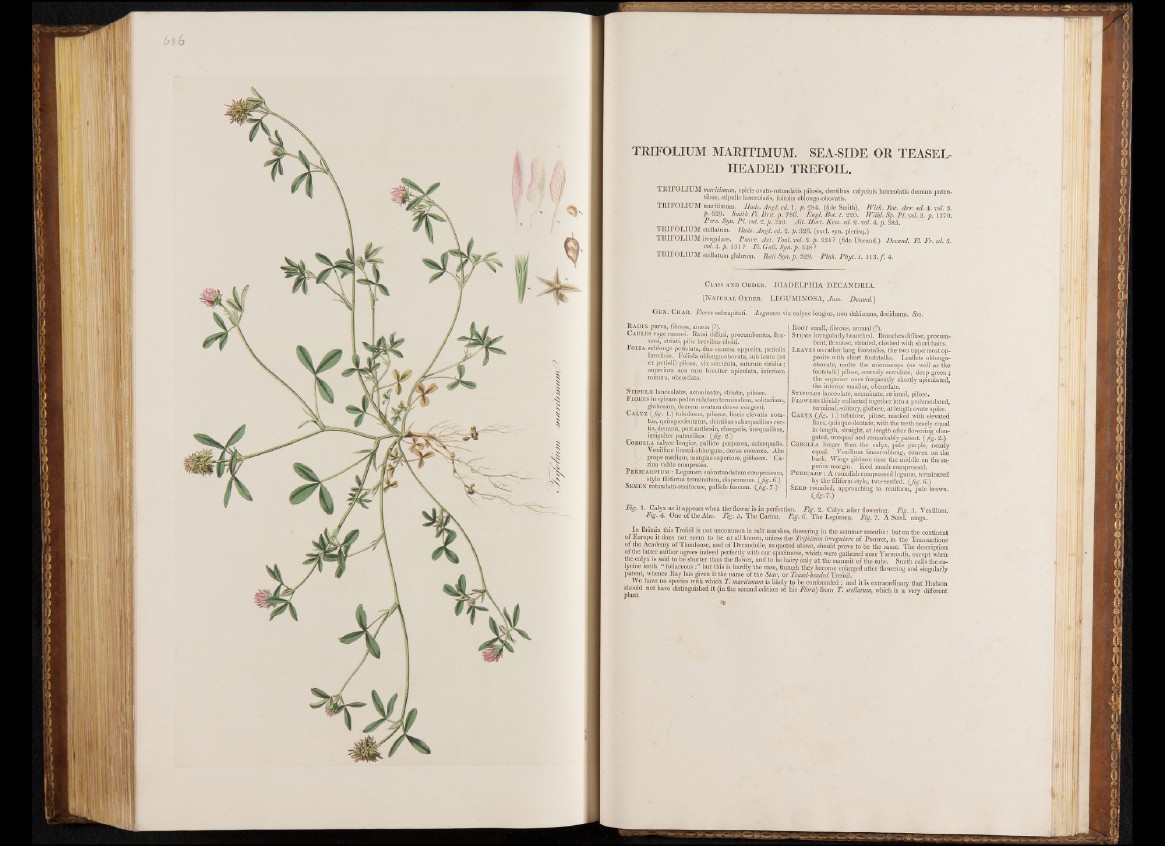
TRIFOLIUM MARITIMUM. SEA-SIDE OR TEASEL-
HEADED TREFOIL.
TRIFOLIUM maritimum, spicis ovato-rotundatis pilosis, dentibus calycinis lanceolatis demum paten-
tibus, stipulis lanceolatis, foliolis oblongo-obovatis.
TRIFOLIUM maritimum. Huds. Angl. cd. 1 . p. 284. (fide Smith). With. Bot. Arr. ed. 4. ml. 3.
p. 639- Smith Fl. Brit. p . 786. Engl. Bot. t. 220. Willd. Sp. PI. ml. 3. p . 1370.
Pers. Syn. P l. ml. 2.p . 350. Ait. Hort. Kew. ed. 2. ml. 4. p . 385.
TRIFOLIUM stellatum. Huds. Angl. ed. 2. p . 326.' (excl. syn. plerisq.)
TRIFOLIUM irreguläre. Pourr. Act. Toul. ml. 3. p. 331? (fide Decand.) Decand. Fl. Fr. ed. 3.
ml. 4,. p . 531? Fl. Gail. Syn. p . 348 ?
TRIFOLIUM stellatum glabrum. Raii Syn. p . 329. Pluk. Phy t. t. 113. f . 4.
Class a n d Ou d er. DIADELPHIA DECANDRIA.
[N atural Ord e r . LEGUMINOSA, J uss. Decand.']
Ge n . Ch a r . Flores subcapitati. Legumen vix calyce longius, non dehiscens, deciduum. Sm.
R a d ix parva, fibrosa, annua (?). (
Caules vage ramosi. Ranii diffusi, procumbentes, flex-
uosi, striati, pilis brevibus obsiti.
Folia sublonge petiolata, düo summa opposita, petiolis
brevibus. Foliola oblongo-obovata, sub lente (ut
•' et petioli) pilosa, vix serrulata, saturate viridia ;
superiora non raro. breviter apiculata, inferiora
> minora, obcordata.
St ipu l® lanceolate, acuminate, striate, pilos®.
F lores in spicam pedunculatam terminalem, solitariam,
£ globosam, demum ovatam dense congesti.
Calyx (ß g . 1.) tubulosus, pilosus, lineis elevatis n o ta -,
■- tus, quinquedentatus, dentibus subffiqualibus rec-
tis, demum, post anthesin, elongatis, in®qualibus,
insigniter patentibus. (ß g . 2.)
Corolla calyce longior, pallide purpurea, subasqualis.
Vexillum lineari-oblongum, dorso convexo. Ate
prope medium, margine superiore, gibbos®. Ca-
'' rina valde compressa.
P e rica rpium : Legumen subrotundatum compressum,
/ stylo filiformi terminatum, dispermum. (f ig .ß •)
Semen rotundato-reniforme, pallide fuscum. (ß g . 7.)
Root small, fibrous, annual (?).'
Stems irrregularly branched. Branches diffuse, procumbent,
flexuose, striated, clothed with short hairs.
Leaves on rather long footstalks, the two uppermost opposite
with short footstalks. Leaflets oblongo-
obovate, under the microscope (as well as the
footstalk) pilose, scarcely serrulate, deep g reen;
the superior ones frequently shortly apiculated,
the inferior smaller, obcordate.
Stipu l e s lanceolate, acuminate, striated, pilose.
Flowers thickly collected together into a pedunculated,
terminal, solitary, globose, a t length ovate spike.
Calyx (ß g . 1.) tubulose, pilose, marked with elevated
lines, quinque-dentate, with the teeth nearly equal
in length, straight, at length after flowering elongated,
unequal and remarkably patent, (ß g . 2.)
Corolla longer than the calyx, pale purple, nearly
equal. Vexillum linear-oblong, convex on the
back. Wings gibbose near the middle on the superior
margin. Keel much compressed.
P e r ica r p : A roundish compressed legume, terminated
by the filiform style, two-seeded, (ß g . 6.)
Se e d rounded, approaching to reniform, pale brown.
(fig- 7-)
Fig. 1. Calyx as it appears when the flower is in perfection. Fig. 2. Calyx after flowering. Fig. 3. Vexillum.
Fig- 4. One o f the Ate. Fig. 5. The Carina. Fig. 6. The Legumen. Fig. 7. A Seed. magn.
In Britain this Trefoil is not uncommon in salt marshes, flowering in the summer months : but on the continent
of Europe it does not seem to be at all known, unless the Trifolium irregulare of Pourret, in the Transactions
of the Academy of Thoulouse, and of Decandolle, as quoted above, should prove to be the same. The description
o f the latter author agrees indeed perfectly with our specimens, which were gathered near Yarmouth, except when
the calyx is said to be shorter than the flower, and to be hairy only at the summit of the .tube. Smith calls the ca-
lycme teeth “ foliaceous : but this is hardly the case, though they become enlarged after flowering and singularly
patent, whence Ray has given it the name of the Star, or Teasel-headed Trefoil.
We have no species with which T. maritimum is likely to be confounded ; and it is extraordinary that Hudson
should not have distinguished it (in the second edition of his Flora) from T. stellatum, which is a very different
’plant. J
«9